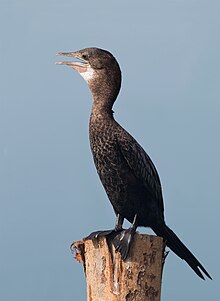
Back غاق أسود Arabic غاق اسود ARZ পানী কাউৰী Assamese Microcarbo niger AST छोटका पनकउआ Bihari ছোট পানকৌড়ি Bengali/Bangla Corb marí de Vieillot Catalan Microcarbo niger CEB Mulfran Jafa Welsh Kleinscharbe German
| Little cormorant | |
|---|---|

| |
| In non-breeding plumage. Note whitish throat patch and brownish plumage. | |
| Scientific classification | |
| Domain: | Eukaryota |
| Kingdom: | Animalia |
| Phylum: | Chordata |
| Class: | Aves |
| Order: | Suliformes |
| Family: | Phalacrocoracidae |
| Genus: | Microcarbo |
| Species: | M. niger
|
| Binomial name | |
| Microcarbo niger (Vieillot, 1817)
| |
| Synonyms | |
|
Halietor niger | |
The little cormorant (Microcarbo niger) is a member of the cormorant family of seabirds. Slightly smaller than the Indian cormorant it lacks a peaked head and has a shorter beak. It is widely distributed across the Indian Subcontinent and extends east to Java, where it is sometimes called the Javanese cormorant. It forages singly or sometimes in loose groups in lowland freshwater bodies, including small ponds, large lakes, streams and sometimes coastal estuaries. Like other cormorants, it is often found perched on a waterside rock with its wings spread out after coming out of the water. The entire body is black in the breeding season but the plumage is brownish, and the throat has a small whitish patch in the non-breeding season. These birds breed gregariously in trees, often joining other waterbirds at heronries.
